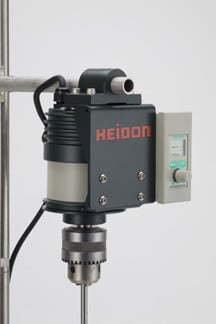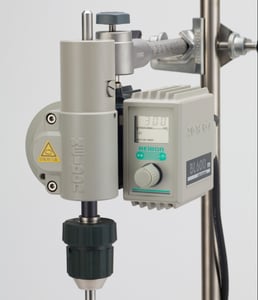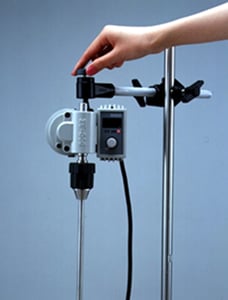 Laboratory mixing is an exact science. Whether creating new polymers and plastics, or mixing pulp, paper, or chemicals, results must be accurate, reliable, and perhaps most importantly, repeatable. This means that having the proper instruments on hand is key.
Laboratory mixing is an exact science. Whether creating new polymers and plastics, or mixing pulp, paper, or chemicals, results must be accurate, reliable, and perhaps most importantly, repeatable. This means that having the proper instruments on hand is key.
After all, the products developed in these labs touch nearly every part of our lives. We count on plastics to keep us safe in our vehicles. We also rely on safe, secure polymer storage systems to maintain the efficacy of our pharmaceuticals, keep them out of the reach of tiny hands, and much more.
So, the key is not only to find laboratory mixers of the highest caliber but also to find laboratory mixers that will hold up to the toughest viscosities, reach the right rotations per minute to achieve your desired outcomes, and withstand the test of time.
Here’s what you need to know about finding the right laboratory mixer for you.
Considerations to Keep in Mind
The most important step to take when choosing the right laboratory mixer is to determine what your lab’s needs are—and what performance specifications you’ll have to meet. Some considerations to think about include:
- The range of speeds you’ll need
- The viscosity range of the test samples
- How you plan to introduce multiple materials into the mixer
- The temperature of the samples you’ll be mixing
- How the temperature of the mixer may impact your final result
- The capacity of the test container and size of the mixer (and if you want to use a mixer that comes with its own container, or use existing containers, like those your test subjects are stored in)
Each lab mixing system comes with its own purpose, and you’ll want to find the one that best suits your intended uses. For example, in a cosmetics lab, you may be mixing liquids, gels, creams, or emulsions, which means you’ll need a mixer that can handle the many different kinds of products you’ll be developing. Chemist’s Corner suggests thinking about:
- Finding a mixer with enough torque for your solution
- Your formula’s sample size
- The maximum mixing speed each mixer can reach
You will also want to think about other features or needs like steady mixing speeds, reciprocating agitators, keyless chucks, programmable settings, auto-reversing, torque measurement, thermal motor protection, and separate attachments.
Choosing the Best Mixer For Your Lab
A mismatched mixer, or rather, a mixer that isn’t suited to your lab’s needs, can wreak havoc in the laboratory. As an example, you may run into issues combining materials with multiple viscosities, which can form “ring layers,” which refers to the phenomenon when differing viscosities settle at different depths for a poorly-mixed or weak product. Other issues can arise when combining chemicals with the wrong mixer, which can have volatile results.
These kinds of issues are not at all helpful when products or mixtures are in the development stages. In a laboratory setting, accuracy is critical for results to be reproducible on a larger scale. This is where Kett’s unique series of mixer models can make a positive impact on your laboratory.
Kett’s mixer model series is made up of three separate performance lines. Each of these performance lines includes three or models at differing speeds, and all of which are at the forefront of the industry for mixing. Features of all three include:
- Digital controls and amazing motor torque for consistent speeds, even when the viscosity changes in an instant
- Keyless chucks, for secure, easy-to-change mixing shafts
- Free-Joint™ swivel mounts, to change shafts and adjust the mixing height without moving the motor
- Unique reciprocating motion to automatically raise and lower the mixing action for faster, more efficient mixing and no ring layer regions
- Change of rotational direction with the touch of one button
- Shafts, stands, blades, and stoppers are available for all models
- LED digital displays, 0.5-second sampling frequencies, and 110VAC power sources
- A dual safety system with both thermal motor protection and a current limiter
So, how do you know which of these is the right choice for your lab? How can you tell them apart? The three performance series are:
- BL Series: The BL Series features a maintenance-free brushless motor and a forward/reverse rotation function for efficient mixing.
- BLh Series: The BLh Series offers a higher-powered 70W brushless motor with automatic forward/reverse rotation for improved mixing performance.
- BLW Series: The BLW Series uses a robust 120W motor for high-viscosity liquids and enhanced torque, expanding its application range.
In addition to these performance series, Kett provides extra features to enhance your mixing experience:
- BL-R Series: The BL-R Series includes remote control models for fume hood use, with external output for rotation speed and torque control.
- BLh-R Series: The BLh-R Series is a remote-controlled agitator with a 70W motor, ideal for demanding agitation tasks and external control capabilities.
- FT Series: The FT Series provides analog voltage outputs for rotation speed and torque, allowing viscosity monitoring with a recording meter during agitation.
- Z+ Series: Unique design automatically raises and lowers blade to reduce or eliminate "ring zone" in mixtures that have widely varied viscosities or are normally difficult to efficiently mix.
Here are some of the distinct differences between a few of these models.
The BL300
This model comes with an RPM rate between 0 and 300 rotations per minute, with a related torque of 9.0Kgf/cm. The BL300 can stand up to high viscosities and is equipped for dual rotation.
The BL600
This model goes a bit faster, reaching an RPM of up to 600 RPM and includes reciprocating action. The related torque of this model is 10.0Kgf/cm and is ideal for medium-to-high viscosities. It has full dual rotation capabilities.
The BL1200
A faster model in Kett’s mixing system line with an RPM of as much as 1,000 and related torque of 3.0Kgf/cm This model covers a low to medium viscosity range and can handle dual rotation for as long as 30 minutes.
Get Help from Professionals
Truthfully, the right mixer for you comes down to a few easy-to-decipher factors: Speed, related torque, and viscosity.
At Kett, we have seen firsthand the impact the right laboratory mixing system can have. With all of our instrument options, there’s a solution for everyone. Our expert engineers have the experience and technical knowledge to point you in the right direction.
Want more guidance to discover which laboratory mixer is right for you? Contact us today!


